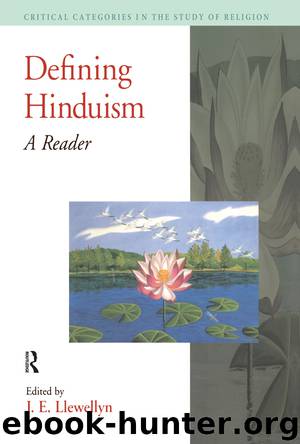Defining Hinduism by J. E. Llewellyn

Author:J. E. Llewellyn
Language: eng
Format: epub
Publisher: Taylor & Francis Ltd
Somewhat later, Radhakrishnan would similarly write (again using the “Vedanta” for the essential heart of “pure religion”): “The Vedanta is not a religion, but religion itself in its most universal and deepest significances” (1968, 18; cited in Halbfass 1988, 409).
While traditional Brahman authorities were the sources for one kind of western definition of Hinduism, the Neo-Hindus—acting out of their own interests and propagating their own agenda—were dialectically creating another version of “Hinduism” with another, and much more dominant, branch of Indology. Neo-Hindu articulations of Hinduism provide us with the Indian side of the same coin, stamped with the mainstream of Indological views of the tradition. Hinduism, in both cases, is not a religion comparable to others. The all-encompassing, pluralistic nature of the beast defies definition—it either is incomparable to other religions or was “religion” itself, the summary and supersession of all “religions.”
Hinduism, it is claimed by both Neo-Hindus and Indologists, can be and is virtually everything. But for the Neo-Hindus, this nondefinition of Hinduism has played a different role than it has for western scholars. The latter have, it would seem, resisted definition out of befuddlement, atavistic notions of a “mysterious East” that defies rational categories, or simply failure of will; the former have done so largely out of concerns revolving around cultural pride and nationalistic aspirations. And, in either case, the end result is not dissimilar to the recent deconstructionist critique: There really is no such thing as “Hinduism” if by that term we mean a tradition that is both unified and bounded.16
The third set of native authorities that is challenged by contemporary deconstructionists is comprised of the Hindu nationalists, commonly called the Hindutva movement. Originating at about the turn of the twentieth century, this movement has recently undergone quite a revival and has become a major factor in modern Indian politics. Perhaps even more than traditional Brahmans and Neo-Hindus, it is the Hindu nationalist authorities and their pronouncements about Hinduism that many contemporary scholars have challenged by denying the existence of either a “Hinduism” or a “Hindu community.”
Romila Thapar, in a widely cited article (1985), has argued that the Hindutva movement is creating a new form of “Hinduism” out of the pluralistic and variegated realities of the Indic subcontinent. She has labeled this monolith “syndicated Hinduism,” formulated in reaction to the historical encounter with Semitic religions:
The new Hinduism which is being currently propagated by the Sanghs, Parishads and Samajs is an attempt to restructure the indigenous religions as a monolithic, uniform religion, rather paralleling some of the features of Semitic religions. This seems to be a fundamental departure from the essentials of what may be called the indigenous “Hindu” religions (Thapar 1985, 15).
Download
This site does not store any files on its server. We only index and link to content provided by other sites. Please contact the content providers to delete copyright contents if any and email us, we'll remove relevant links or contents immediately.
The Lost Art of Listening by Michael P. Nichols(7154)
Why I Am Not A Calvinist by Dr. Peter S. Ruckman(4045)
The Rosicrucians by Christopher McIntosh(3369)
Wicca: a guide for the solitary practitioner by Scott Cunningham(3037)
Signature in the Cell: DNA and the Evidence for Intelligent Design by Stephen C. Meyer(2875)
Real Sex by Lauren F. Winner(2861)
The Holy Spirit by Billy Graham(2775)
To Light a Sacred Flame by Silver RavenWolf(2667)
The End of Faith by Sam Harris(2626)
The Gnostic Gospels by Pagels Elaine(2390)
Waking Up by Sam Harris(2325)
Nine Parts of Desire by Geraldine Brooks(2275)
Jesus by Paul Johnson(2223)
Devil, The by Almond Philip C(2198)
Heavens on Earth by Michael Shermer(2184)
The God delusion by Richard Dawkins(2178)
Kundalini by Gopi Krishna(2087)
Chosen by God by R. C. Sproul(2051)
The Nature of Consciousness by Rupert Spira(1967)
